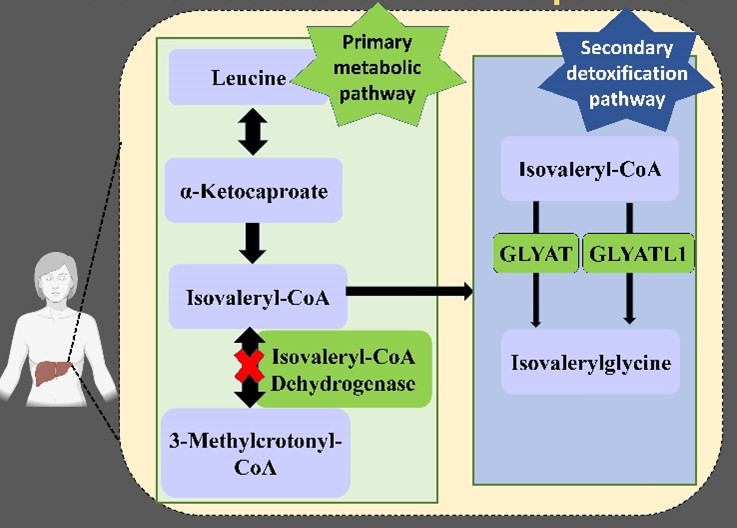Research
Background to research
What is Biochemical Genetics?
Biochemical Genetics is the study of the relationships between genes and enzymes, specifically the role of genes in controlling the steps in biochemical pathways. The focus of our research is to elucidate the role of secondary detoxification pathways in alleviating the symptoms experienced by organic acidaemia patients. We specialise in genetic variation and enzyme function studies, specifically the effect of genetic variation on enzyme function. We hope to improve the quality of life of patients through a better understanding of individual enzymes responsible for detoxifying toxic metabolites.
Current research
Isovaleric acidemia (IVA), due to isovaleryl-CoA dehydrogenase (IVD) deficiency, results in the accumulation of isovaleryl-CoA, isovaleric acid and secondary metabolites (Figure 1). The increase in these metabolites decreases mitochondrial energy production and increases oxidative stress. This contributes to the neuropathological features of IVA. A general assumption in the literature exists that glycine N-acyltransferase (GLYAT) plays a role in alleviating the symptoms experienced by IVA patients through the formation of isovalerylglycine. GLYAT forms part of the phase II glycine conjugation pathway in the liver and detoxifies excess acyl-CoA’s namely benzoyl-CoA. However, very few studies support GLYAT as the enzyme that conjugates isovaleryl-CoA to glycine. In this study we evaluated the ability of GLYAT and GLYATL1, a paralogue of GLYAT, to form isovalerylglycine.
The relative enzyme activity studies showed that both GLYAT and GLYATL1 can form isovalerylglycine. Furthermore, contrary to established treatment methodologies, increasing the glycine concentration in vitro did not result in an increase in the formation of isovalerylglycine. This study supports the recommendation that primary substrates of GLYAT (e.g. preservatives such as benzoate) and GLYATL1 be limited through dietary changes in IVA patients in order to promote the formation of isovalerylglycine. The complex interplay between genetic variations, metabolite concentrations, dietary supplementation, and the kinetics of GLYAT and GLYATL1 likely account for the observed interindividual variation in the amount of isovalerylglycine excreted by IVA patients.

Figure 1. The role of secondary detoxification in eliminating isovaleryl-CoA in IVA.
